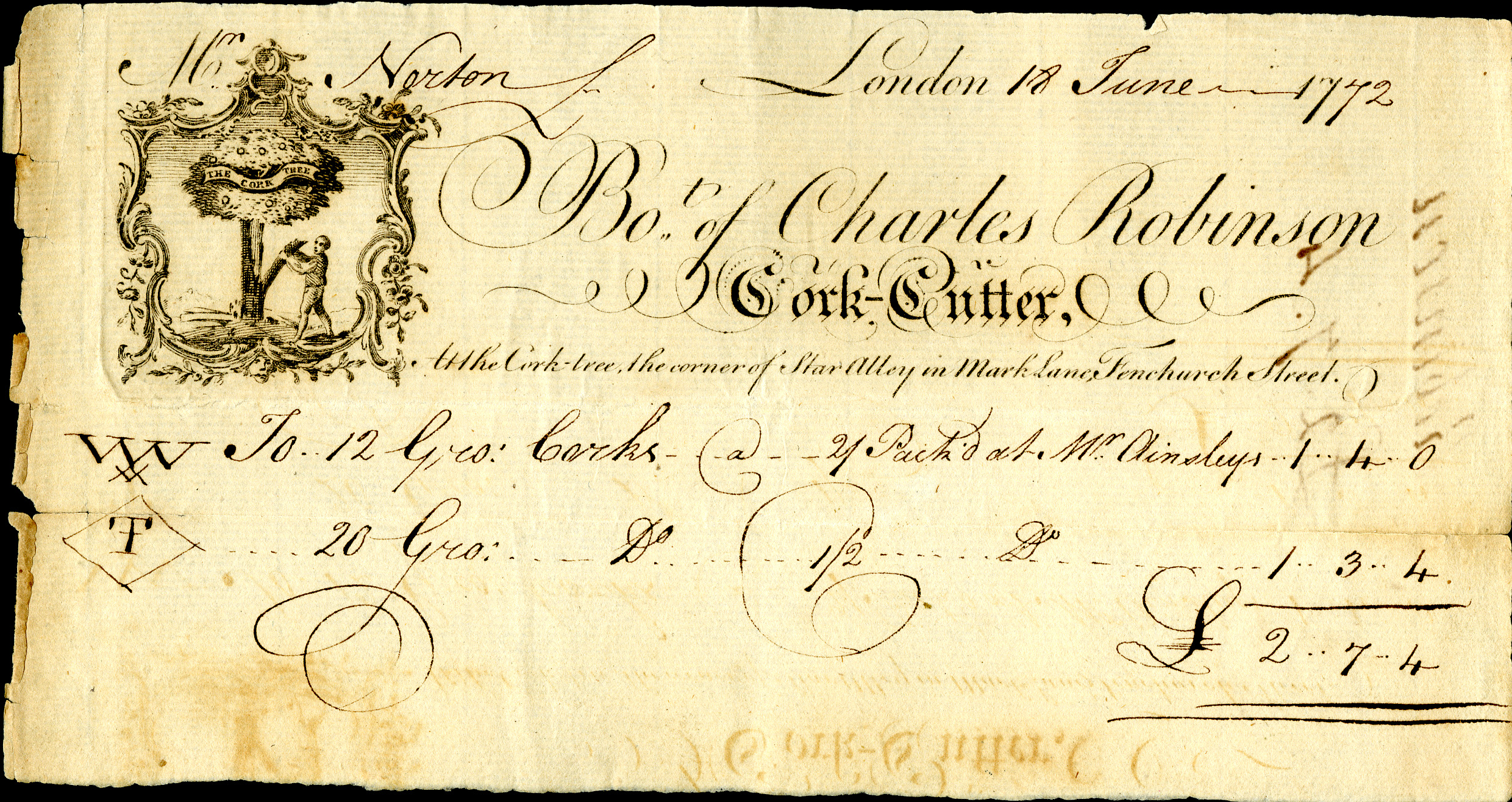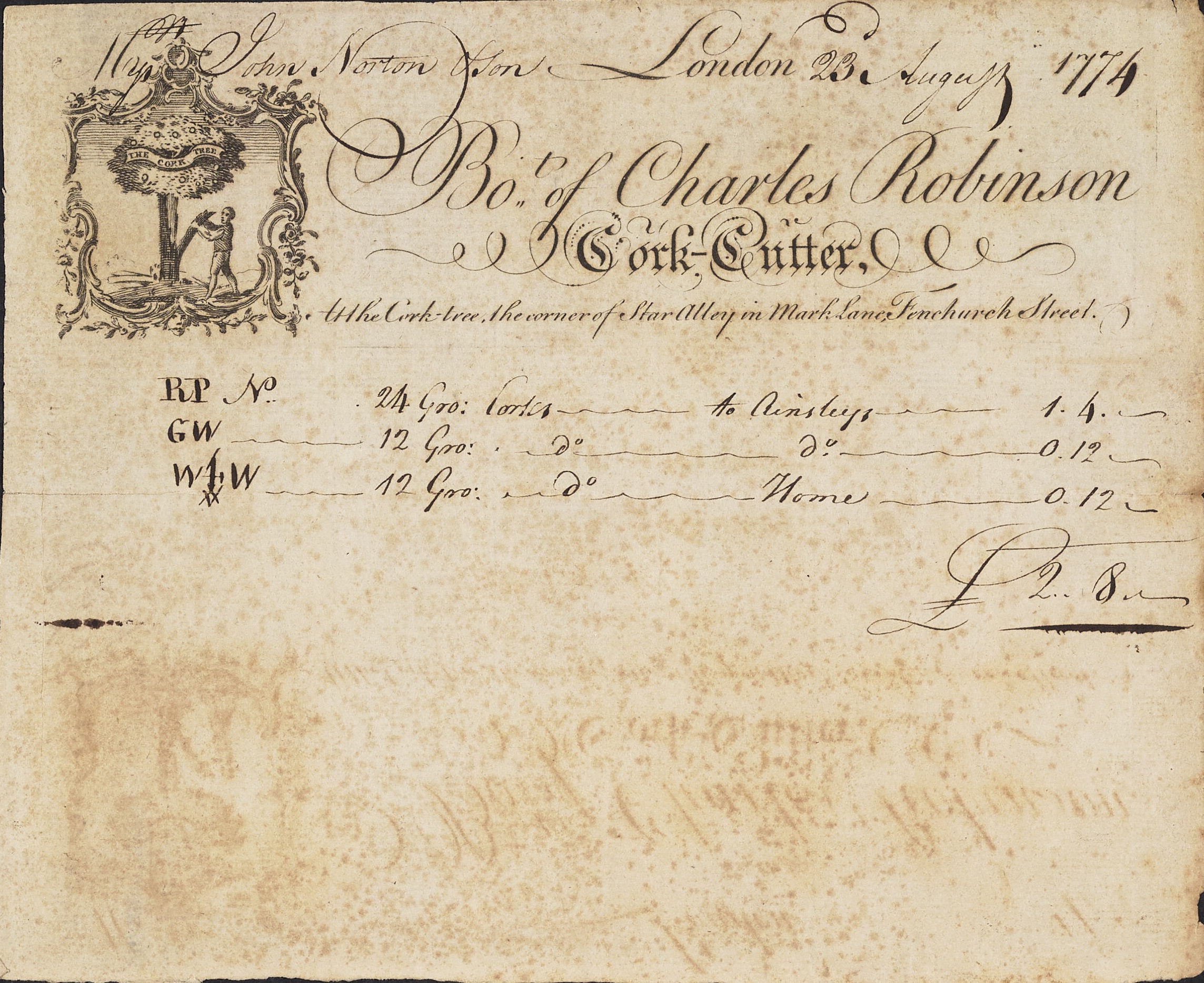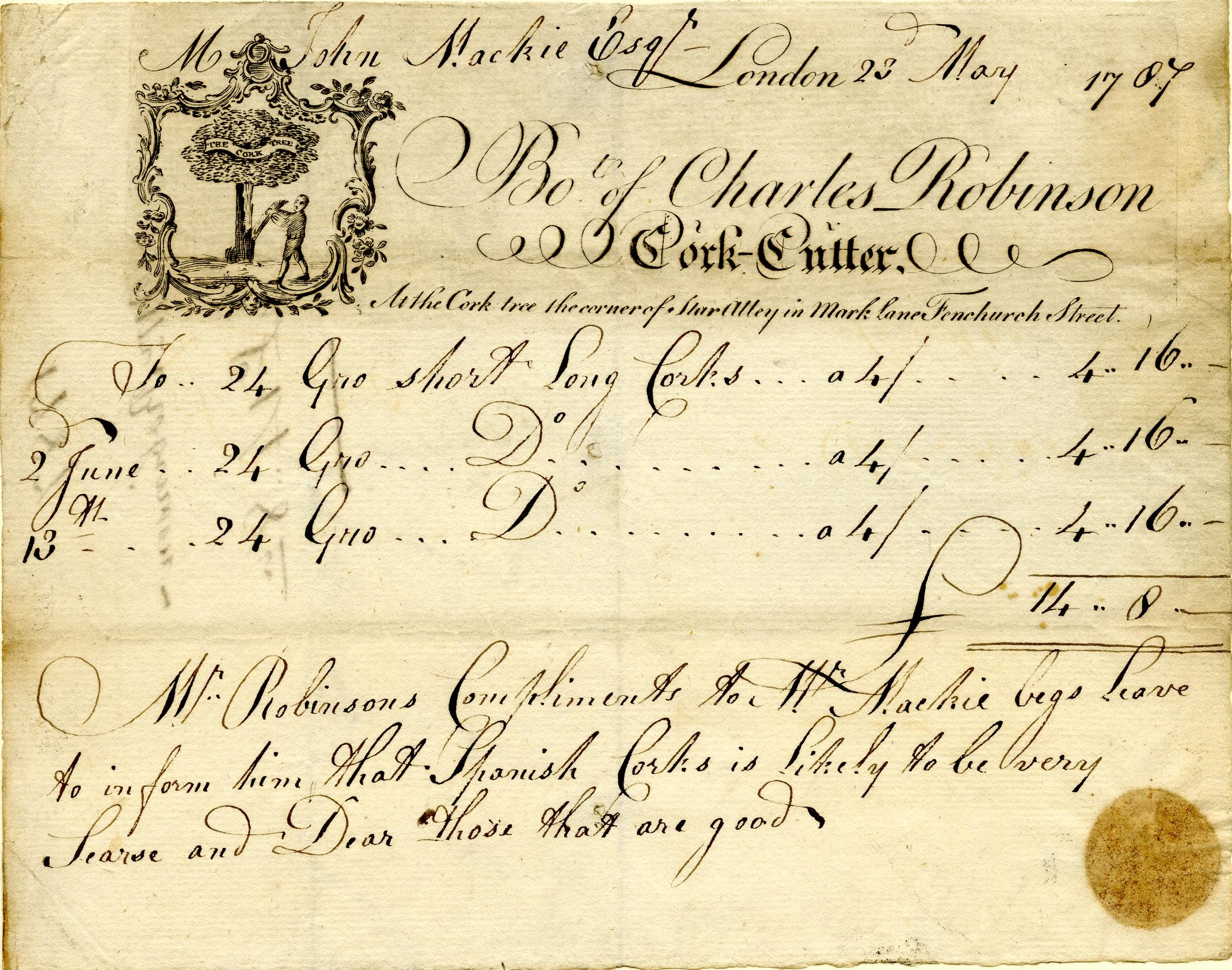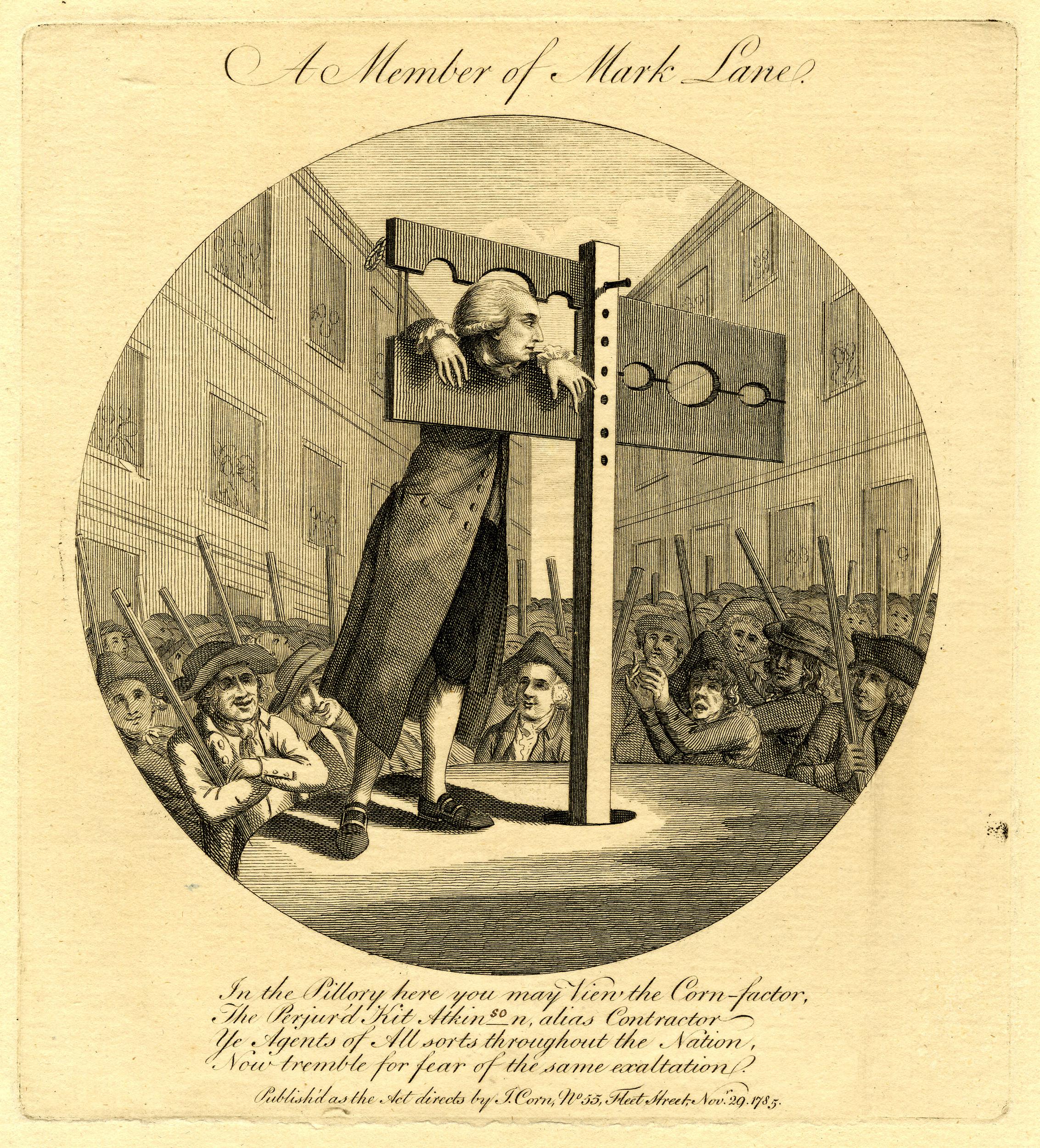| Home |
| Cork-Cutters of Mark Lane, London |
Previous: William Peter Knolton
Charles Robinson
Charles Robinson’s tenure as a cork-cutter in Mark Lane, in the parish of All Hallows Staining, London, followed that of his father-in-law William Peter Knolton, who himself appears to have been introduced to the business through his wife.
On 6 January 1767, the parish register of St Mary’s Church, Whitechapel, East London, recorded the marriage of Charles Robinson, widower of the parish, and Elizabeth Knolton of the parish of All Hallows Staining, the daughter of William Peter Knolton. Elizabeth’s father, established as a cork-cutter at the corner of Star Alley, Mark Lane, passed away just ten months later. The business continued under the new management of Charles Robinson.
Kent’s London Directory for 1772 gave the address of Charles Robinson’s cork-cutter operation as No. 6 Mark Lane.
Bills issued by Charles Robinson, over the period 1772 to 1787, now preserved in archives, give a record of the cork-cutter’s work as a supplier of corks for sealing bottles of wine and liquor. The bill-head gave directions about his business location: the shop was identified by the sign of the cork tree at ‘the corner of Star Alley in Mark Lane, Fenchurch Street’. The upper left of the bill displayed a picture showing a worker stripping the bark from a cork tree.
Three Receipted Bills
| |
| Bill dated London, 18 June 1772
| |
 | |
from
John Norton and
Sons Papers  , Special Collections, , Special Collections,
John D. Rockefeller Jr. Library, Colonial Williamsburg Foundation. | |
| Bill dated London, 23 August 1774
| |
 | |
from
John Norton and
Sons Papers  , Special Collections, , Special Collections,
John D. Rockefeller Jr. Library, Colonial Williamsburg Foundation. | |
| Bill dated London, 23 May 1787
| |
 | |
from
Heal Collection,
British Museum  . .
|
The bills itemized batches of cork stoppers in the amounts of
12, 20 or 24 gross. A gross is 144 items (a dozen dozen); so
a batch of 24 gross contained 3,456 corks.
In 1774 Charles Robinson charged £1. 4s. for 24 gross
of cork stoppers. In 1787 the charge for the same amount was
Mr Robinson’s compliments to Mr Mackie begs leave to inform him that Spanish Corks is likely to be very scarse [scarce] and dear, those that are good.
The bills of 1772 and 1774 documented the business of Charles Robinson as a manufacturer of cork products while the firm of John Norton & Son handled the wholesale distribution. Kent’s London Directory for 1772 had a listing for John Norton & Son, merchants, No. 8 Gould Square, Crutched Friars. This was near the Mark Lane location of Charles Robinson’s workshop – Mark Lane turns into Hart Street which connects to Crutched Friars.
There is a record that John Norton & Son delivered orders to customers in colonial America. The Virginian planter James Carter sent this request to Norton:
Send me immediately 100 gross of the best viol corks . . . .
I can’t carry on my business for want of them. (1)
It was noted above that in 1774 Charles Robinson charged £1. 4s. for 24 gross of hand-cut cork stoppers. However, it can be expected that James Carter paid considerably more – his supplier John Norton would have added a markup and then trans-Atlantic shipping costs were an extra expense.
In early America, for the contemporaries of James Carter, the effective use of corks for bottle sealers presented a number of challenges:
Experts advised that bottlers not reuse corks. ‘Economy in corks is very unwise,’ warned one, because it would ‘run the risk of losing the valuable article it is intended to preserve.’ Planters had to treat many of their corks to make them create good seals. Some planters dipped corks in a mixture of rosin, beeswax, and brick-dust and then laid them out to dry. Others preferred to dip their corks in a mixture of white wax and beef suet, repeating ‘the dipping till they are saturated.’ In a pinch, colonists could plug their bottles with cloth made stiff from sealing wax or with glass stoppers, but corks kept cider longer. After waxing, the corks still had to be tied to the bottles with copper or iron wire. A ship captain listed the cost of wiring corks for bottles of rum, beer, and wine at a half-shilling per bottle in a catalog of his expenses. (2)
At the time Charles Robinson occupied No. 6 Mark Lane one of his neighbours was Christopher Atkinson (c.1738–1819) who ran his business at No. 15 Mark Lane. Atkinson, a corn factor and contractor for wheat and malt to the Navy Victualling Board, also had a career as an MP (member of parliament). In July 1783 he was found guilty of cheating by overcharges and false accounting, and sentenced to stand in the pillory (3). Viewing this grim punishment provided a form of public entertainment in Georgian London.
Christopher Atkinson was pilloried outside the Corn Exchange in Mark Lane – possibly Charles Robinson viewed the spectacle from near his workshop. The drama of the event has been illustrated in prints.
Christopher Atkinson pilloried, Print published 1785
| |
 | |
from
The British Museum  . .
Another dramatization of the scene is an etching by Thomas Rowlandson in the collection of the Wellcome Library  , London. , London.
Another interesting picture is in the print collection of the London Metropolitan Archives  . .
|
Over the period 1768 to 1784, five daughters and four sons of Charles and Elizabeth Robinson were baptised at All Hallows Staining Church. At the same church, Charles Robinson was buried on 4 December 1793.
The will of Charles Robinson revealed that his real estate holdings included two houses in Mark Lane and a leasehold house as well as ‘warehouses, coach houses, and stables’ in Billiter Lane, which ran north from the junction of Mark Lane and Fenchurch Street. In the will, his entire estate was bequeathed to his ‘loving wife’ Elizabeth (4). This suggests that Charles Robinson had great confidence that his wife possessed the business acumen to direct the cork-cutter enterprise at No. 6 Mark Lane into the next century. He also trusted that Elizabeth would provide generously for their children.
Nineteenth Century
A news publication from April 1803 released a dividend announcement by Elizabeth Robinson, cork-cutter of Mark Lane (5). Kent’s London Directory for 1803 gave the shop address as No. 6 Mark Lane (6).
Elizabeth Robinson continued to run the cork-cutter business at Mark Lane until her death in August 1806. She was buried in the churchyard of All Hallows Staining Church; the burial register recorded her age as 57.
After 1806, the cork-cutter workshop at No. 6 Mark Lane came under the new management of John Higginson who was connected to the Robinson family by marriage – his sister Rebecca was the wife of John Ignatious Robinson, the son of Charles and Elizabeth Robinson. The Higginson family who, since at least 1780, had been active as cork-cutters in Southwark, managed the Mark Lane cork-cutter outlet until about 1827.
From records of the Sun Fire Office, John Barrett, cork-cutter of 6 Mark Lane, purchased a fire insurance policy on 5 November 1828 (7). During the 1830s, John Barrett, cork-cutter, 6 Mark Lane, had an entry in the annual Post Office London Directories.
By 1841, Barrett had moved his cork-cutter business to 8 Star Alley, around the corner from Mark Lane (8). This marked the departure from 6 Mark Lane of the cork-cutters who had plied their trade there for a period spanning one hundred years.
The 1841 Post Office London: Street Directory listed the occupants of 6 Mark Lane as Edmeston & Wilden, flour factors; William Harvey, wine importer; Nathaniel Johnston & Sons, wine merchants; and Juan José Pico, merchant (9).
General References
Databases, with browsable document images, hosted by Ancestry online:
- London Directories, London Metropolitan Archives and Guildhall Library.
- London parish registers, London Metropolitan Archives.
Notes
- Notes on the Knolton / Roebuck / Robinson Families
- Notes on the Higginson Family
(1)
Sarah Hand Meacham, Every Home a Distillery: Alcohol, Gender, and
Technology in the Colonial Chesapeake,
The John Hopkins University Press, Baltimore, 2009, p. 58
(Google book preview  ).
The term ‘viol corks’ appears old usage; possibly
it refers to vial corks.
).
The term ‘viol corks’ appears old usage; possibly
it refers to vial corks.
(2) Sarah Hand Meacham, Every Home a Distillery, p. 58.
(3)
Biographical notes about Christopher Atkinson are provided by the
British
Museum  ; and the
History
of Parliament
; and the
History
of Parliament  .
As further punishment Christopher Atkinson was required to pay a
fine of £2,000, and to be imprisoned for twelve months.
.
As further punishment Christopher Atkinson was required to pay a
fine of £2,000, and to be imprisoned for twelve months.
(4) Prerogative Court of Canterbury (PCC) Will of Charles Robinson probated 2 December 1793 (National Archives).
(5)
The Agricultural Magazine, April 1803, p. 314
(Google eBook  ).
).
(6)
Kent’s London Directory for 1803 (p. 169) had an entry for
‘Robinson E., Cork-cutter, 6 Mark Lane’
(Google eBook  ).
).
(7)
London Metropolitan Archives online catalogue,
reference code: CLC/B/192/F/001/MS11936/512/1082377.
A record entry is also in the National Archives online catalogue.
(8)
In the 1841 census (reference: HO107/719/9, folio 7, page 9)
John Barrett, cork cutter, aged 45, born in London, was living at
Star Alley, in the parish of All Hallows Staining, with Ann Barrett,
aged 55, and Henry Butcher, aged 15, cork cutter apprentice
(note: in the 1841 census, the age was rounded down to the nearest
five for those aged 15 or over).
In the 1851 census (reference: HO107/1532, folio 380), John Barrett,
cork cutter, aged 60, born in Shoreditch [East London], was residing at
5 Three Herring Court [Creechurch Lane], in the parish of St Katherine Cree,
London, with his wife, Ann Barrett, mid-wife, aged 70, born in
Bristol, Gloucestershire.
(9) In the 1850 Post Office London: Commercial Directory, Juan José Pico was named as a wine merchant at 10 Fenchurch Buildings.
Text Copyright © WhistlerHistory 2023.